spare wheel CHEVROLET ASTRO 1996 Owners Manual
[x] Cancel search | Manufacturer: CHEVROLET, Model Year: 1996, Model line: ASTRO, Model: CHEVROLET ASTRO 1996Pages: 372, PDF Size: 21.51 MB
Page 216 of 372
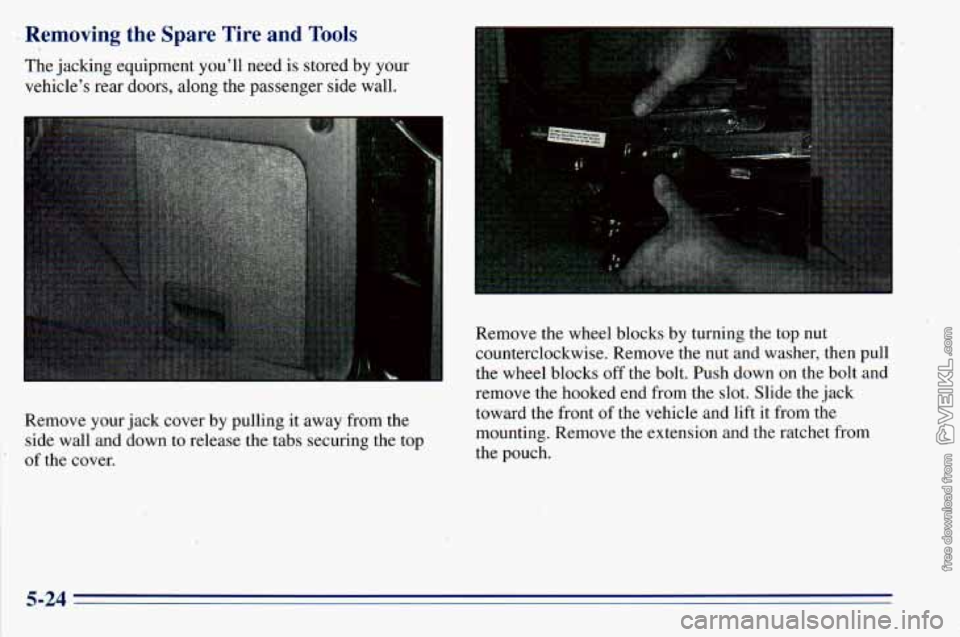
- Removing the Spare Tire and Tools
The jacking equipment you’ll need is stored by your
vehicle’s rear doors, along the passenger side wall.
Remove your jack cover by pulling
it away from the
side wall and down to release the tabs securing the top
‘ of the cover. Remove the wheel, blocks by turning the top nut
counterclockwise. Remove the nut and washer, then pull
the wheel blocks off the bolt. Push down on the bolt and
remove the hooked
end from the slot. Slide the jack
toward the front of the vehicle and lift it from the
mounting. Remove the extension and the ratchet from
the pouch.
5-24
Page 221 of 372
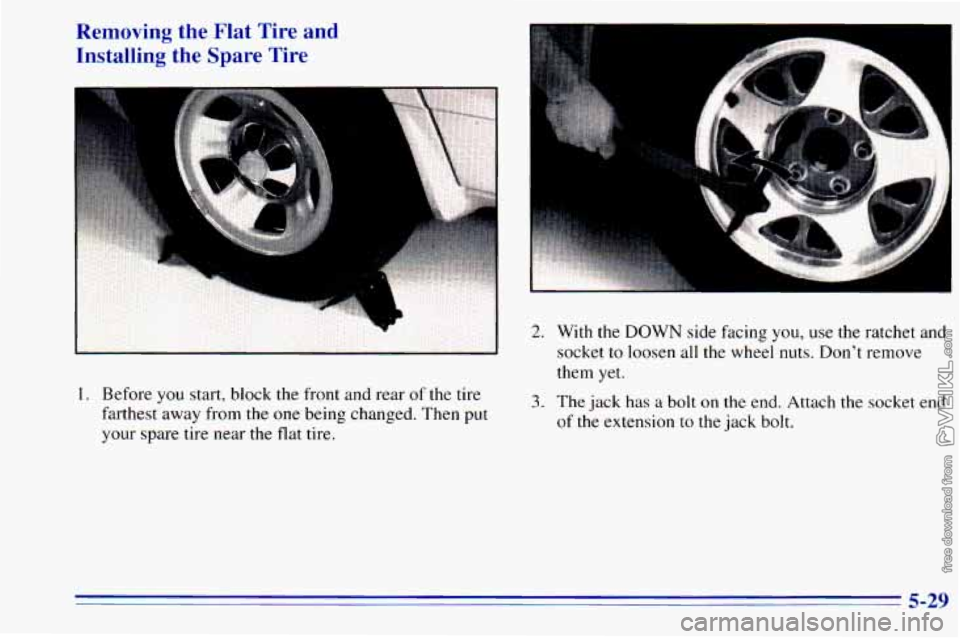
Removing the Flat Tire and
Installing the Spare Tire
-.
1. Before you start, block the front and rear of the tire
farthest away from the one being changed. Then put
your spare tire near
the flat tire.
F
2. With the DOWN side facing you, use the ratchet and
socket to loosen
all the wheel nuts. Don't remove
them
yet.
3. The jack has a bolt on the end. Attach the socket end
of the extension to the jack bolt.
5-29
Page 223 of 372

1
Getting under a vehicle when it is jacked up is
dangerous.
If the vehicle slips off the jack, you ~
could be badly injured or killed. Never get under
a vehicle when it
is supported only by a jack.
NOTICE:
Raising your vehicle with the jack improperly
positioned will damage the vehicle or may allow
the vehicle to fall
off the jack. Be sure to fit the
jack lift head into the proper location before
raising
your vehicle.
Do not jack up the vehicle with people in or near
the vehicle.
7. Raise the vehicle by rotating the ratchet clockwise.
Make sure the
UP mark faces you. Raise the vehicle
far enough off the ground
so there is enough room
for the spare tire to fit.
8. Remove all the wheel nuts and take off the flat tire.
5-31
Page 224 of 372
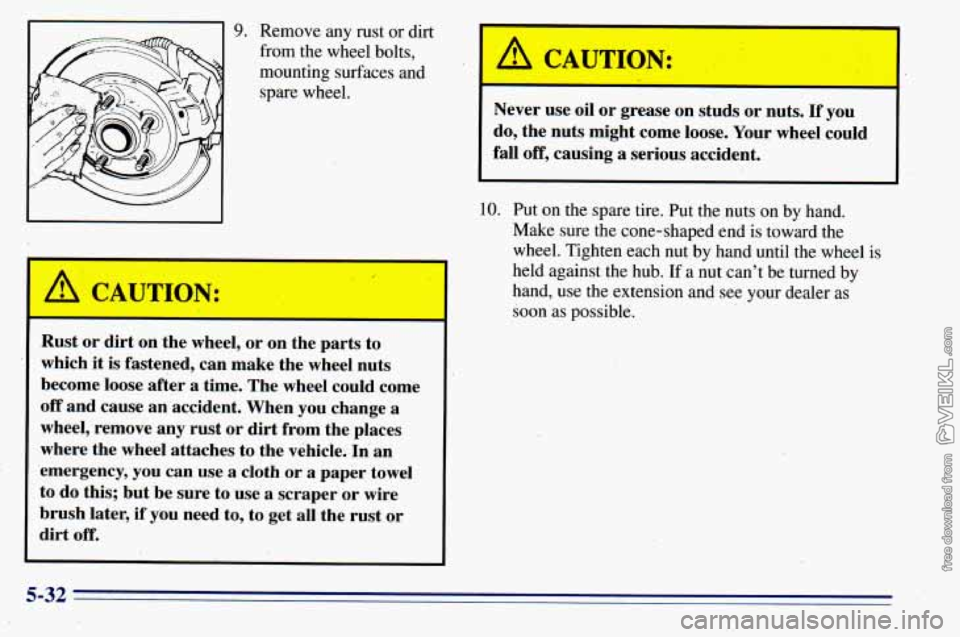
I I
9.
A CAUTION:
Remove any rust or dirt
from the wheel bolts,
mounting surfaces and
spare wheel.
-
Never use oil or grease on studs or nuts. If you
do, the nuts might come loose. Your wheel could
fall
off, causing a serious accident.
Rust or dirt on the wheel, or on tL parts to
which it is fastened, can make the wheel nuts
become loose after a time. The wheel could come
off and cause an accident. When you change a
wheel, remove any rust or dirt from the places
where the wheel attaches to the vehicle..In an
emergency, you can use a
cloth or a paper towel
to do this; but be sure to use a scraper or wire
brush later, if ybu need to, to get all the rust or
dirt
off.
10. Put on the spare tire. Put the nuts on by hand.
Make sure the cone-shaped end is toward the
wheel. Tighten each
nut by hand until the wheel is
held against the hub.
If a nut can’t be turned by
hand, use the extension and see your dealer as
soon as possible.
5-32
Page 226 of 372
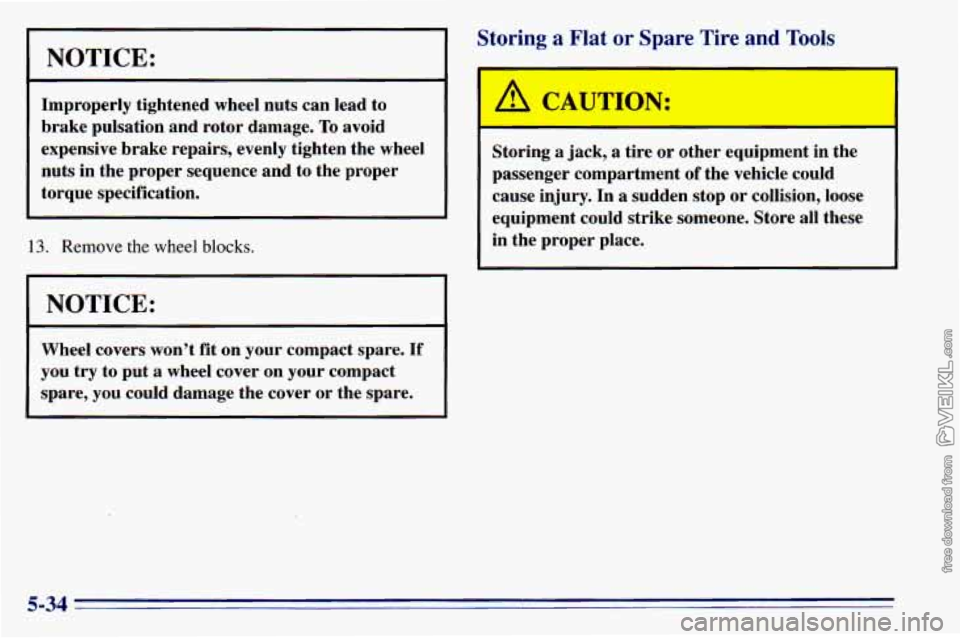
NOTICE:
Improperly tightened wheel nuts can lead to
brake pulsation and rotor damage.
To avoid
expensive brake repairs, evenly tighten the wheel
nuts in the proper sequence and to the proper
torque specification.
13. Remove the wheel blocks.
I NOTICE:
Wheel covers won't fit on your compact spare. If
you try to put a wheel cover on your compact
spare, you could damage the cover or the spare. Storing
a jack, a tire or other equipment in the
passenger compartment
of the vehicle could
cause injury. In a sudden stop or collision, loose
equipment could strike someone. Store all these
in the proper place.
5-34
Page 227 of 372
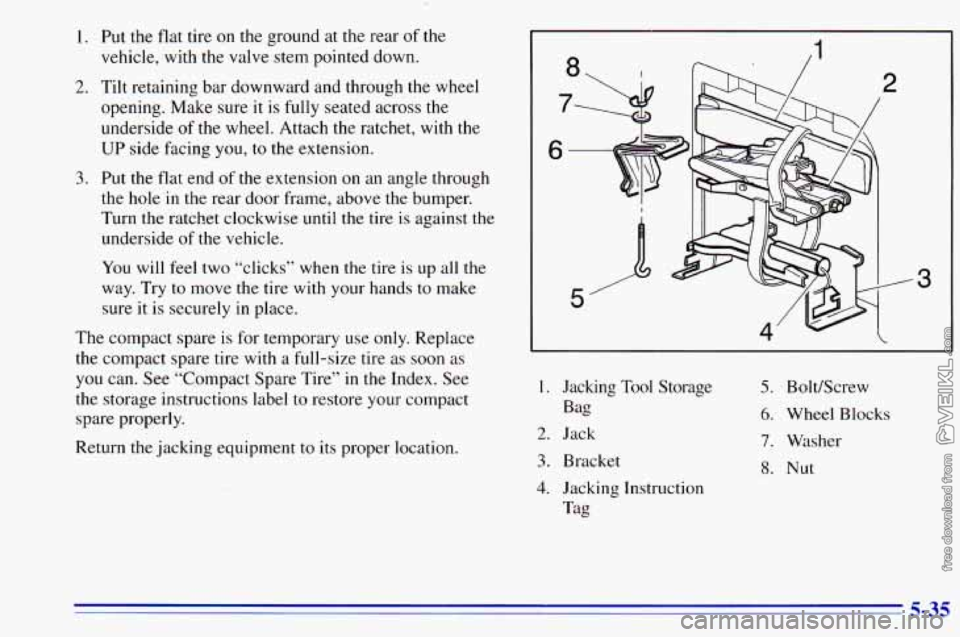
1.
2.
3.
Put the flat tire on the ground at the rear of the
vehicle, with the valve stem pointed down.
Tilt retaining bar downward and through the wheel
opening. Make sure it is fully seated across the
underside of the wheel. Attach the ratchet, with the
UP side facing you, to the extension.
Put the
flat end of the extension on an angle through
the hole in the rear door frame, above the bumper.
Turn the ratchet clockwise until the tire is against the
underside
of the vehicle.
You will
feel two “clicks” when the tire is up all the
way. Try to move the tire with your hands to make
sure it is securely in place.
The compact spare is for temporary use only. Replace
the compact spare tire with a full-size tire
as soon as
you can. See “Compact Spare Tire” in the Index. See
the storage instructions label to restore your compact
spare properly.
Return the jacking equipment
to its proper location.
I 4
3
I. Jacking Tool Storage
Bag
2. Jack
3. Bracket
4. Jacking Instruction
Tag
5. BoltKcrew
6. Wheel Blocks
7, Washer
8. Nut
5-35
Page 228 of 372
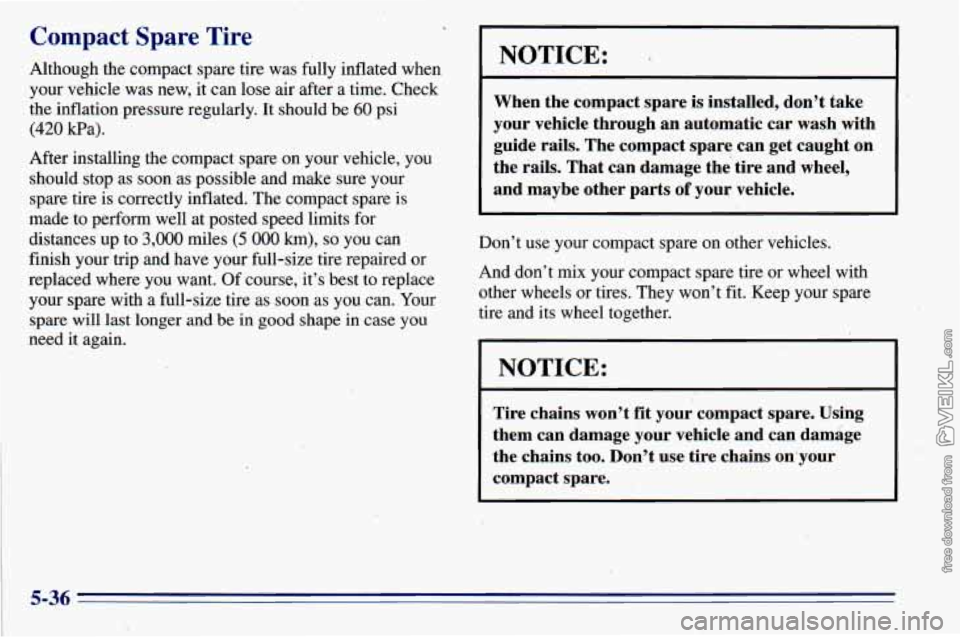
Compact Spare Tire
Although the compact spare tire was fully inflated when
your vehicle was new, it can lose air after a time. Check
the inflation pressure regularly. It should be
60 psi
(420 Wa).
After installing the compact spare on your vehicle, you
should stop as soon as possible and make sure your
spare tire
is correctly inflated. The compact spare is
made to perform well at posted speed limits for
distances up to
3,000 miles (5 000 km), so you can
fini.sh your trip and have your full-size tire repaired or
replaced where you want. Of course, it’s best to replace
your spare with a full-size tire as soon as you can. Your
spare will last longer and be in good shape in case
you
need it again.
NOTICE:
I
When the compact spare is installed, don’t take
your vehicle through an automatic car wash with
guide rails. The compact spare can get caught on
the rails. That can damage the tire and wheel,
and maybe other parts
of your vehicle.
Don’t use
your compact spare on other vehicles.
And don’t mix your compact spare tire or wheel with
other wheels or tires. They won’t fit. Keep your spare
tire and its wheel together.
NOTICE:
Tire chains won’t fit your compact spare. Using
them can damage your vehicle and can damage
the chains too. Don’t use tire chains on’your
compact spare.
5-36
Page 274 of 372
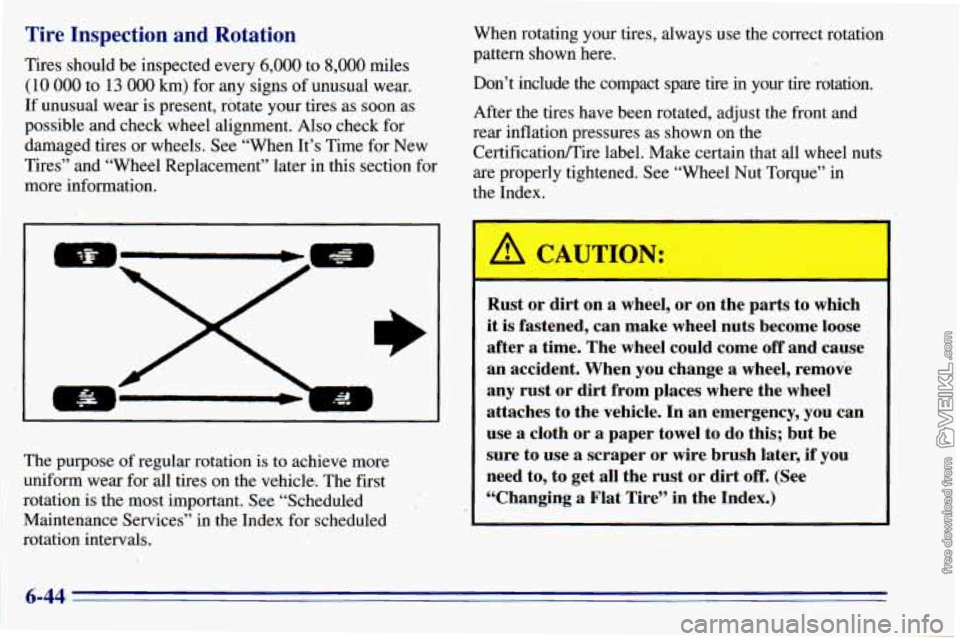
Tire Inspection and Rotation
Tires should be inspected every 6,000 to 8,000 miles
(10 000 to 13 000 km) for any signs of unusual wear.
If unusual wear is present, rotate your tires as soon as
possible and check wheel alignment. Also check for
damaged tires or wheels. See “When It’s Time for New
Tires” and “Wheel Replacement” later in this section for
more information.
The purpose of regular rotation
is to achieve more
uniform wear for all tires on the vehicle. The first
rotation is the most important. See “Scheduled
Maintenance Services” in the Index for scheduled
rotation intervals. When
rotating your tires, always use the correct rotation
pattern shown here.
Don’t include the compact spare tire in your tire rotation. \
After the tires have been rotated, adjust the front and
rear inflation pressures as shown on the
CertificatiodTire label. Make certain that all wheel nuts
are properly tightened. See “Wheel
Nut Torque” in
the Index.
’ A CAUTIO1
Rust or dirt on a wheel, or on the parts to which
it
is fastened, can make wheel nuts become loose
after a time. The wheel could come
off and cause
an accident. When you change a wheel, remove
any rust or dirt from places where the wheel
attaches to the vehicle. In an emergency, you can
use a cloth or a paper towel to do this; but be
sure to use a scraper or wire brush later,
if you
need to, to get all the rust or dirt
off. (See
“Changing
a Flat Tire” in the Index.)
Page 276 of 372
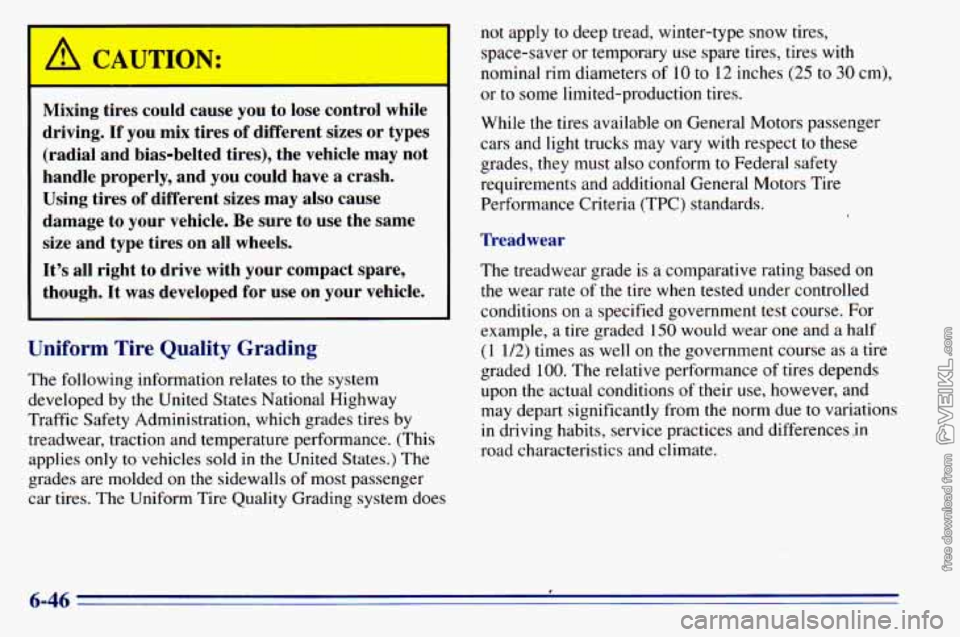
I
ng tires could cause you to lose control while
driving. If you mix tires of different sizes or types
(radial and bias-belted tires), the vehicle may not
handle properly, and you could have
a crash.
Using tires of different sizes may also cause
damage to your vehicle. Be sure to use the same
size and type tires on all wheels.
It’s all right to drive with your compact spare,
though. It was developed
for use on your vehicle.
Uniform Tire Quality Grading
The following information relates to the system
developed by
the United States National Highway
Traffic Safety Administration, which grades tires by
treadwear, traction and temperature performance. (This
applies
only to vehicles sold in the United States.) The
grades are molded on the sidewalls of most passenger
car tires. The Uniform Tire Quality Grading system does not apply to
deep tread, winter-type snow tires,
space-saver or temporary use spare tires, tires with
nominal rim diameters
of 10 to 12 inches (25 to 30 cm),
or to some limited-production tires.
While
the tires available on General Motors passenger
cars and light trucks may vary with respect to
these
grades, they must also conform to Federal safety
requirements and additional General Motors Tire
Performance Criteria (TPC) standards.
Treadwear
The treadwear grade is a comparative rating based on
the wear rate of the tire when tested under controlled
conditions on
a specified government test course. For
example, a tire graded
150 would wear one and a half
(1 1/2) times as well on the government course as a tire
graded
100. The relative performance of tires depends
upon the actual conditions of their use, however, and may depart significantly from the norm due to variations
in driving habits, service practices and differences Jn
road characteristics and climate.
6-46
d
Page 362 of 372
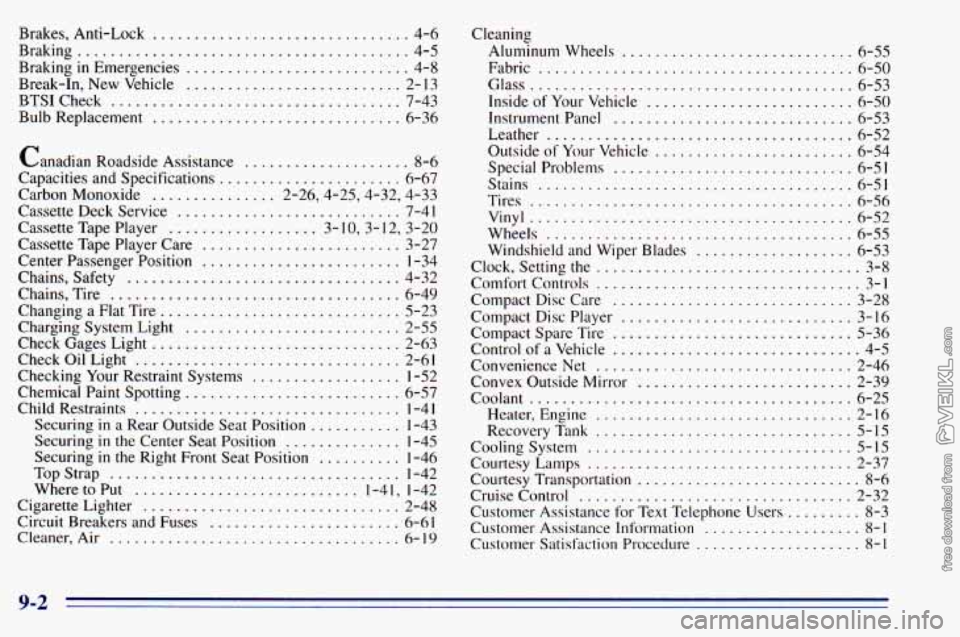
Brakes. Anti-Lock ............................... 4-6
Braking
........................................ 4-5
Braking
in Emergencies ........................... 4-8
Break-In. New Vehicle
.......................... 2- 13
BTSICheck ................................... 7-43
Bulb Replacement
.............................. 6-36
Canadian Roadside Assistance
.................... 8-6
Capacities and Specifications
...................... 6-67
Carbon Monoxide
............... 2.26.4.25.4.32. 4.33
Cassette Deck Service
........................... 7-41
Cassette Tape Player
.................. 3- 10. 3. 12. 3.20
Cassette Tape Player Care
........................ 3-27
Center Passenger Position
........................ 1-34
Chains. Safety
................................. 4-32
Chains. Tire
................................... 6-49
Changing a Flat Tire
............................. 5-23
Charging System Light
.......................... 2-55
Check Gages Light
.............................. 2-63
Check Oil Light
................................ 2-61
Checking
Your Restraint Systems .................. 1-52
Chemical Paint Spotting
.......................... 6-57
Child Restraints
................................ 1-4 I
Securing in a Rear Outside Seat Position ........... 1-43
Securing
in the Center Seat Position .............. 1-45
Securing
in the Right Front Seat Position .......... 1-46
TopStrap
................................... 1-42
Where to Put
........................... 1-4 I. 1-42
Cigarette Lighter
............................... 2-48
Circuit Breakers and Fuses
....................... 6-61
Cleaner. Air ................................... 6-19 Cleaning
Aluminum Wheels ............................ 6-55
Fabric
...................................... 6-50
Glass
....................................... 6-53
Inside
of Your Vehicle ......................... 6-50
Instrument Panel
............................. 6-53
Leather
..................................... 6-52
Outside
of Your Vehicle ........................ 6-54
Special Problems
............................. 6-51
Stains
...................................... 6-51
Tires
....................................... 6-56
Vinyl ....................................... 6-52
Wheels
..................................... 6-55
Windshield and Wiper Blades
................... 6-53
Clock. Setting the
................................ 3-8
Comfort Controls
................................ 3-1
Compact Disc Care
............................. 3-28
Compact Disc Player
............................ 3-16
Compact Spare Tire
............................. 5-36
Control of a Vehicle .............................. 4-5
ConvenienceNet
............................... 2-46
Convex Outside Mirror
.......................... 2-39
Coolant
....................................... 6-25
Heater. Engine
............................... 2-16
RecoveryTank
............................... 5-15
Courtesy Lamps
................................ 2-37
Courtesy Transportation
........................... 8-6
Cruise Control
................................. 2-32
Customer Assistance for Text Telephone Users
......... 8-3
Customer
Assistance Information ................... 8-1
Customer Satisfaction Procedure .................... 8-1
Cooling System
................................ 5-15
9-2